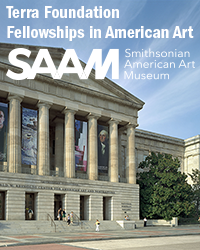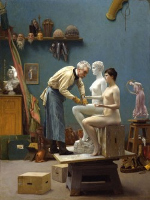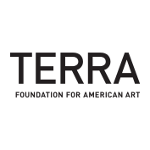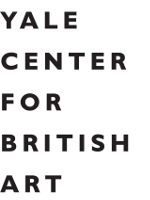X
Please wait for the PDF.
The browser will either open the file, download it, or display a dialog.
The browser will either open the file, download it, or display a dialog.
INTRODUCTION
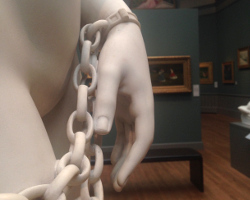
Read the article >
This special issue on Hiram Powers’s Greek Slave offers a sustained examination of one of the most famous sculptures of the nineteenth century. This introduction explains the twin themes of the “transatlantic” and the “object,” which underpin this project’s approach. Moving the statue out of an insistently American frame, the sixteen articles presented here consider The Greek Slave as a set of objects that crossed and re-crossed the Atlantic. Displayed in many contexts and locations, the statue became both an icon of the shared Anglo-American culture of the nineteenth century and a symbol of the cultural and political divisions generated by America’s slave trade. This special issue examines The Greek Slave not as a single object for which any reproduction acts as a surrogate, but as a series of distinctive objects, including the six full-size statues and the varied reproductions that take the form and name of The Greek Slave.
close
This special issue on Hiram Powers’s Greek Slave offers a sustained examination of one of the most famous sculptures of the nineteenth century. This introduction explains the twin themes of the “transatlantic” and the “object,” which underpin this project’s approach. Moving the statue out of an insistently American frame, the sixteen articles presented here consider The Greek Slave as a set of objects that crossed and re-crossed the Atlantic. Displayed in many contexts and locations, the statue became both an icon of the shared Anglo-American culture of the nineteenth century and a symbol of the cultural and political divisions generated by America’s slave trade. This special issue examines The Greek Slave not as a single object for which any reproduction acts as a surrogate, but as a series of distinctive objects, including the six full-size statues and the varied reproductions that take the form and name of The Greek Slave.

abstract
Read the article >
This article examines the exhibition, sales, and ownership history of the six versions of The Greek Slave that Hiram Powers made between 1843 and 1866. While the historiography has largely focused on the iconography and subject of The Greek Slave, this study argues for the importance of considering the trajectories of the original statues themselves.
close
This article examines the exhibition, sales, and ownership history of the six versions of The Greek Slave that Hiram Powers made between 1843 and 1866. While the historiography has largely focused on the iconography and subject of The Greek Slave, this study argues for the importance of considering the trajectories of the original statues themselves.
MAKING THE GREEK SLAVE
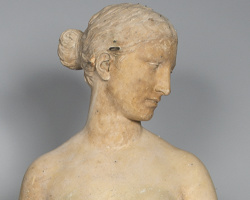
Read the article >
This article retraces the steps Hiram Powers took in making The Greek Slave, from modeling the clay to supervising the carving of six full-scale marble replicas. It closely examines the structure and surface of a plaster model of this sculpture (1843, Smithsonian American Art Museum) and presents this object as a key to understanding the sculptor’s studio practice and as a tool for assessing similarities and differences across the marble examples of this sculpture.
close
This article retraces the steps Hiram Powers took in making The Greek Slave, from modeling the clay to supervising the carving of six full-scale marble replicas. It closely examines the structure and surface of a plaster model of this sculpture (1843, Smithsonian American Art Museum) and presents this object as a key to understanding the sculptor’s studio practice and as a tool for assessing similarities and differences across the marble examples of this sculpture.
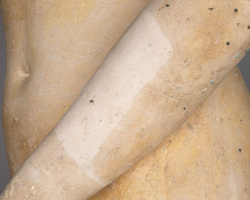
Read the article >
This article focuses on the evidence revealed during the technical examination and conservation treatment of a plaster model of The Greek Slave used by stone carvers in Hiram Powers’s studio to produce finished marble copies. Observations focus on what both the internal “skeleton” and the exterior “skin” revealed during the conservation process that supports a history of the plaster model’s repeated use, as well as offers details about the role of intermediates in historical studio technique. Also presented is the use of 3-D scanning as a digital tool for art historical research in addition to its enabling the making of a 3-D “print” of the plaster model suitable for gallery display.
close
This article focuses on the evidence revealed during the technical examination and conservation treatment of a plaster model of The Greek Slave used by stone carvers in Hiram Powers’s studio to produce finished marble copies. Observations focus on what both the internal “skeleton” and the exterior “skin” revealed during the conservation process that supports a history of the plaster model’s repeated use, as well as offers details about the role of intermediates in historical studio technique. Also presented is the use of 3-D scanning as a digital tool for art historical research in addition to its enabling the making of a 3-D “print” of the plaster model suitable for gallery display.
REPRODUCING THE GREEK SLAVE
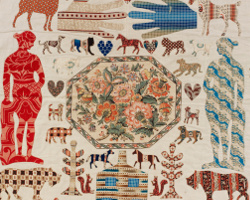
Read the article >
As one of the most widely reproduced sculptures of the nineteenth century, Hiram Powers’s Greek Slave was a landmark statue defined in relation to its own reproduction. This article considers how the popularity of The Greek Slave at exhibition turned the statue into a ubiquitous subject for a wide range of reproductive media including prints, calotypes, daguerreotypes, stereoviews, statuettes, and even textiles. It explores these reproductive representations as sites of sculptural display that shaped the experience of the statue for vast and varied audiences and as self-reflexive and interpretative responses to the dissemination of a shackled nude across the transatlantic Victorian world.
close
As one of the most widely reproduced sculptures of the nineteenth century, Hiram Powers’s Greek Slave was a landmark statue defined in relation to its own reproduction. This article considers how the popularity of The Greek Slave at exhibition turned the statue into a ubiquitous subject for a wide range of reproductive media including prints, calotypes, daguerreotypes, stereoviews, statuettes, and even textiles. It explores these reproductive representations as sites of sculptural display that shaped the experience of the statue for vast and varied audiences and as self-reflexive and interpretative responses to the dissemination of a shackled nude across the transatlantic Victorian world.
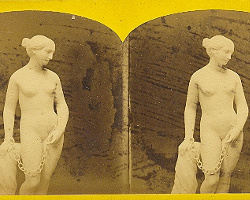
Read the article >
This visual essay explores photographs of Hiram Powers’s Greek Slave sculpture taken and/or circulated in Britain in the nineteenth century, focusing on their materiality as daguerreotypes, salted paper prints, or stereographs. The statue’s popularity at the time makes it an effective case study through which to evaluate the early successes and failures of photography as a means of reproducing works of sculpture. At the time, sculpture was used to attract attention to photography, yet photography succeeded precisely by making itself invisible, to satisfy the desire of owning works of art—even if only as copies—as long as the reproduction process did not interfere with the impress of genius left by the touch of the artist.
close
This visual essay explores photographs of Hiram Powers’s Greek Slave sculpture taken and/or circulated in Britain in the nineteenth century, focusing on their materiality as daguerreotypes, salted paper prints, or stereographs. The statue’s popularity at the time makes it an effective case study through which to evaluate the early successes and failures of photography as a means of reproducing works of sculpture. At the time, sculpture was used to attract attention to photography, yet photography succeeded precisely by making itself invisible, to satisfy the desire of owning works of art—even if only as copies—as long as the reproduction process did not interfere with the impress of genius left by the touch of the artist.
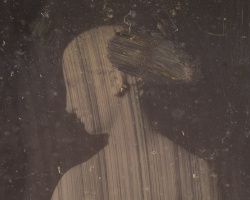
Read the article >
This article presents a daguerreotype from the collection of the Smithsonian American Art Museum in Washington, DC, as the only known image of the fourth version of The Greek Slave.
close
This article presents a daguerreotype from the collection of the Smithsonian American Art Museum in Washington, DC, as the only known image of the fourth version of The Greek Slave.
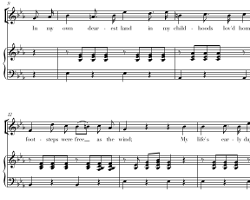
abstract
Read the article >
Sheet music was an important cultural phenomenon of the Victorian age. Hiram Powers’s Greek Slave inspired several musical compositions, which raise important issues about the musical, visual, and commodity culture of Victorian Britain. This article accompanies and examines the implications of newly recorded performances of works neglected since the 1850s, including S. W. New’s ballad The Greek Slave and Louis Antoine Jullien’s The Greek Slave Waltz.
close
Sheet music was an important cultural phenomenon of the Victorian age. Hiram Powers’s Greek Slave inspired several musical compositions, which raise important issues about the musical, visual, and commodity culture of Victorian Britain. This article accompanies and examines the implications of newly recorded performances of works neglected since the 1850s, including S. W. New’s ballad The Greek Slave and Louis Antoine Jullien’s The Greek Slave Waltz.
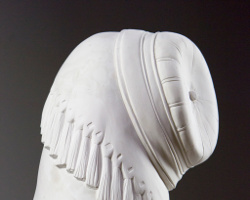
Read the article >
Alex Potts interviews sculptor Lily Cox-Richard in relation to her recent project The Stand (Possessing Powers). Each of these plaster sculptures takes a major work by Hiram Powers, such as The Greek Slave, as its starting point, removing the naked female figure for which Powers is best known and isolating and refashioning the stand—the part most people ignore. The transformation effected by such a radical displacement of the figure and refashioning of the stand as an autonomous sculpture paradoxically draws attention to a significance inherent in Powers’s work which might otherwise be ignored. Cox-Richard’s project raises important questions about how Powers’s work can still speak to a contemporary artist for whom the core values informing his conception of sculpture are in many respects radically alien.
close
Alex Potts interviews sculptor Lily Cox-Richard in relation to her recent project The Stand (Possessing Powers). Each of these plaster sculptures takes a major work by Hiram Powers, such as The Greek Slave, as its starting point, removing the naked female figure for which Powers is best known and isolating and refashioning the stand—the part most people ignore. The transformation effected by such a radical displacement of the figure and refashioning of the stand as an autonomous sculpture paradoxically draws attention to a significance inherent in Powers’s work which might otherwise be ignored. Cox-Richard’s project raises important questions about how Powers’s work can still speak to a contemporary artist for whom the core values informing his conception of sculpture are in many respects radically alien.
CONTEXTUALIZING THE GREEK SLAVE
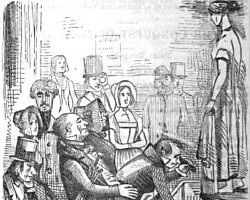
abstract
Read the article >
In 1847, the American sculptor Hiram Powers sent the second marble version of The Greek Slave (1846, The Corcoran Collection, National Gallery of Art, Washington, DC) on an American tour, entrusting the statue and exhibition logistics to an old friend and colleague, Miner K. Kellogg. This article considers the intersecting role of artist and agent in the American presentation of The Greek Slave, examining exhibition precedents, the logistics of the tour, techniques used to attract audiences, and the dynamics of the operation as relations between artist and agent shifted from cooperative to eventually divisive.
close
In 1847, the American sculptor Hiram Powers sent the second marble version of The Greek Slave (1846, The Corcoran Collection, National Gallery of Art, Washington, DC) on an American tour, entrusting the statue and exhibition logistics to an old friend and colleague, Miner K. Kellogg. This article considers the intersecting role of artist and agent in the American presentation of The Greek Slave, examining exhibition precedents, the logistics of the tour, techniques used to attract audiences, and the dynamics of the operation as relations between artist and agent shifted from cooperative to eventually divisive.
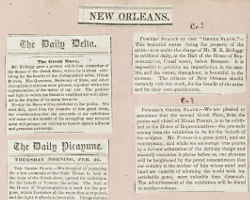
Read the article >
“Notices of Powers [sic] Work,” a nineteenth-century scrapbook in the collection of the Archives of American Art (Smithsonian Institution, Washington, DC) is filled with newspaper clippings detailing the acclaim given to Hiram Powers’s Greek Slave sculptures (second and third versions) during their North American tour in 1847–51. Mounted chronologically, the notices relate the story of the marbles’ arrival and generally positive public reception in various cities. They culminate in press detailing the arrival of the second copy to a controversial owner, James Robb of New Orleans. This article considers the origin of the Greek Slave tour scrapbook and the pro-Powers narrative constructed therein, balancing that narrative with contrasting evidence from other primary sources.
close
“Notices of Powers [sic] Work,” a nineteenth-century scrapbook in the collection of the Archives of American Art (Smithsonian Institution, Washington, DC) is filled with newspaper clippings detailing the acclaim given to Hiram Powers’s Greek Slave sculptures (second and third versions) during their North American tour in 1847–51. Mounted chronologically, the notices relate the story of the marbles’ arrival and generally positive public reception in various cities. They culminate in press detailing the arrival of the second copy to a controversial owner, James Robb of New Orleans. This article considers the origin of the Greek Slave tour scrapbook and the pro-Powers narrative constructed therein, balancing that narrative with contrasting evidence from other primary sources.
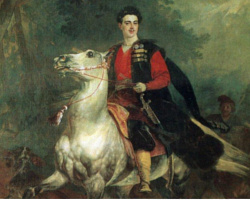
abstract
Read the article >
Presented for profit in public exhibitions, Hiram Powers’s Greek Slave was quickly adopted as a symbol for abolitionists and discussed within the discourse on slavery. In 1851, the art collector Prince Anatole Demidoff acquired the fifth version of the sculpture solely for his own private viewing pleasure and that of his guests in his Villa San Donato, near Florence. This article considers The Greek Slave within the context of the Prince’s social circles and his broader art collection.
close
Presented for profit in public exhibitions, Hiram Powers’s Greek Slave was quickly adopted as a symbol for abolitionists and discussed within the discourse on slavery. In 1851, the art collector Prince Anatole Demidoff acquired the fifth version of the sculpture solely for his own private viewing pleasure and that of his guests in his Villa San Donato, near Florence. This article considers The Greek Slave within the context of the Prince’s social circles and his broader art collection.
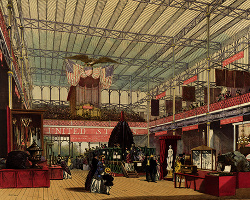
Read the article >
On July 18, 1851, a pioneering abolitionist performance took place within the American section at The Great Exhibition of the Works of Industry of all Nations, commonly known as the Crystal Palace. Gathered in front of The Greek Slave by Hiram Powers and Illustrious Americans, a series of daguerreotypes by Mathew B. Brady, the demonstrators challenged the works’ status as examples of America’s democratic ideals and instead recast them as characters in the tale of the “tragic octoroon.” In front of an international audience, this radical reinterpretation of exhibited artworks implicated the entire American nation in the crime of slavery and presented the horrors of the slave system as America’s most notable product.
close
On July 18, 1851, a pioneering abolitionist performance took place within the American section at The Great Exhibition of the Works of Industry of all Nations, commonly known as the Crystal Palace. Gathered in front of The Greek Slave by Hiram Powers and Illustrious Americans, a series of daguerreotypes by Mathew B. Brady, the demonstrators challenged the works’ status as examples of America’s democratic ideals and instead recast them as characters in the tale of the “tragic octoroon.” In front of an international audience, this radical reinterpretation of exhibited artworks implicated the entire American nation in the crime of slavery and presented the horrors of the slave system as America’s most notable product.
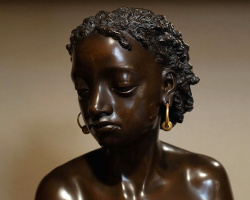
Read the article >
This article contends that John Bell’s American Slave was made as an abolitionist response to Hiram Powers’s Greek Slave. Bell’s statue presented a critique of Powers, and aimed to demonstrate the limits of ideal sculpture in addressing contemporary ethical questions. Like The Greek Slave, Bell’s statue is a transatlantic object, and one that embodies the complexity and contradictions of Anglo-American culture.
close
This article contends that John Bell’s American Slave was made as an abolitionist response to Hiram Powers’s Greek Slave. Bell’s statue presented a critique of Powers, and aimed to demonstrate the limits of ideal sculpture in addressing contemporary ethical questions. Like The Greek Slave, Bell’s statue is a transatlantic object, and one that embodies the complexity and contradictions of Anglo-American culture.
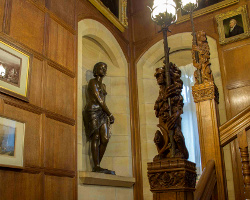
Read the article >
This article considers John Bell’s statue The American Slave in the context of its production by Elkington and Company and its acquisition by the armaments manufacturer Lord William Armstrong. It discusses the display of the statue amongst other images of slavery at Armstrong’s country home at Cragside in Northumberland, and in doing so, meditates on the fraught implications of purchasing and owning a life-size representation of an enslaved body.
close
This article considers John Bell’s statue The American Slave in the context of its production by Elkington and Company and its acquisition by the armaments manufacturer Lord William Armstrong. It discusses the display of the statue amongst other images of slavery at Armstrong’s country home at Cragside in Northumberland, and in doing so, meditates on the fraught implications of purchasing and owning a life-size representation of an enslaved body.
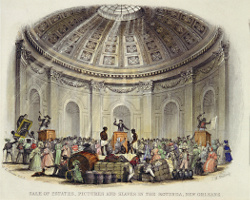
abstract
Read the article >
John Bell’s Octoroon, exploiting the popular iconography of melodramatic representations of the mid-nineteenth-century slave trade, represents a mixed-race woman whose “one-eighth African blood” dooms her to sexual servitude. This article contends that similar auction-block scenes proliferated in novels, plays, and Abolitionist tracts, but they were founded on real conditions and practices.
close
John Bell’s Octoroon, exploiting the popular iconography of melodramatic representations of the mid-nineteenth-century slave trade, represents a mixed-race woman whose “one-eighth African blood” dooms her to sexual servitude. This article contends that similar auction-block scenes proliferated in novels, plays, and Abolitionist tracts, but they were founded on real conditions and practices.
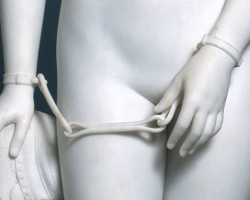
Read the article >
This article revises the author’s original thoughts about Hiram Powers’s Greek Slave published in the now-defunct American Art Journal in 1982. The author now argues that Hiram Powers became aware of Northern and Southern interpretations of The Greek Slave within the context of the antislavery movement as the statue traveled throughout the United States between 1847 and 1849, generating newspaper reviews that his agent Miner K. Kellogg collected, and to which Powers surely would have had access. These published responses, combined with his own shifting attitudes to slavery in his native country as revealed by his correspondence, led to his decision finally in 1869 that both The Greek Slave and his America allude specifically to slavery in the United States.
close
This article revises the author’s original thoughts about Hiram Powers’s Greek Slave published in the now-defunct American Art Journal in 1982. The author now argues that Hiram Powers became aware of Northern and Southern interpretations of The Greek Slave within the context of the antislavery movement as the statue traveled throughout the United States between 1847 and 1849, generating newspaper reviews that his agent Miner K. Kellogg collected, and to which Powers surely would have had access. These published responses, combined with his own shifting attitudes to slavery in his native country as revealed by his correspondence, led to his decision finally in 1869 that both The Greek Slave and his America allude specifically to slavery in the United States.


